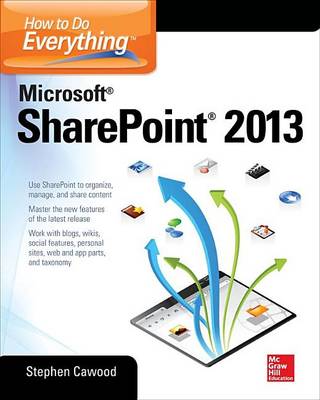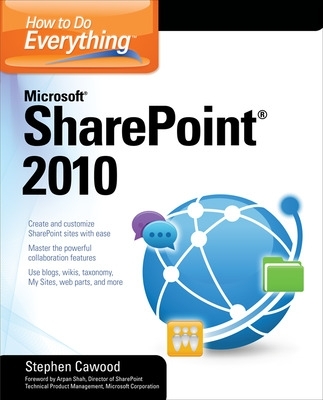How to Do Everything
2 total works
Written by a former member of the SharePoint development team, How to Do Everything: Microsoft SharePoint 2013 shows you how to get the most out of the latest release of this dynamic business collaboration platform. You'll learn to set up SharePoint sites and use document management, wikis, taxonomy, blogs, social features, and more to organize, manage, and share content. Real-world examples help you accomplish tasks quickly and easily. Basic information on SharePoint development and administration is also included in this practical guide.
Work with sites, apps, lists, libraries, and itemsUpload documents, manage files with document libraries, and use document versioning and content approval featuresCollaborate via discussion boards, blogs, wikis, events, surveys, calendars, and newsfeedsUse social tagging, enable a folksonomy, and use enterprise keywords Create a taxonomy hierarchy using enterprise managed metadata Build publishing sites, personal sites, and websites Display data on pages using web and app partsCustomize apps, lists, forms, and navigation Use SharePoint with client applications, including Microsoft Office, Outlook, InfoPath, SharePoint Designer, and third-party applicationsLearn the basics of SharePoint administration and development
Publisher's Note: Products purchased from Third Party sellers are not guaranteed by the publisher for quality, authenticity, or access to any online entitlements included with the product.
Master Microsoft SharePoint 2010
In How to Do Everything: Microsoft SharePoint 2010, Stephen Cawood--a former member of the SharePoint development team--explains how to get the most out of this powerful business collaboration platform. Learn how to use document management functions, wikis, taxonomy, blogs, My Sites, web parts, and more. Take full advantage of the content management, enterprise search, collaboration, and information-sharing capabilities of SharePoint 2010 with help from this practical guide.
- Set up a SharePoint site
- Add documents, use the SharePoint content approval workflow, and work with document versioning features
- Collaborate with others during discussion boards, blogs, wikis, events, surveys, calendars, and workspaces
- Use social tagging to create a folksonomy of keywords
- Create a taxonomy hierarchy using Enterprise Managed Metadata
- Build publishing sites, My Sites, and public-facing websites
- Show data on pages using web parts
- Customize lists, forms, site themes, and navigation
- Use SharePoint with client applications, including Microsoft Office Backstage, Outlook, InfoPath, SharePoint Designer, and third-party applications

